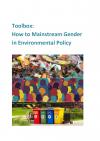Environment and Gender
Introduction

Environmental degradation has gendered impacts that need to be properly assessed and monitored to understand and subsequently adopt gender-responsive strategies and policies. While designing these, it is essential that measures targeting gender equality and women’s empowerment be adequately formulated and mainstreamed. Gender norms can affect the impact that people can have on the environment, and there is still a lack of women in decision-making and leadership positions regarding environmental matters.
Read moreIn focus
Highlights
The Environment Division carries out several activities under the UNECE Gender Action Plan (GAP) . The UNECE GAP 2020 includes objectives for the UNECE environmental intergovernmental framework, including CEP, the governing bodies of the UNECE multilateral environmental agreements, the Working Group on Environmental Monitoring and Assessment, the Steering Committee on Education for Sustainable Development, the Steering Committee of the Transport, Health and Environment Pan- European Programme (THE PEP) and the 2030 Agenda for Sustainable Development implementation activities.
Recent Events
Baku Azerbaijan



